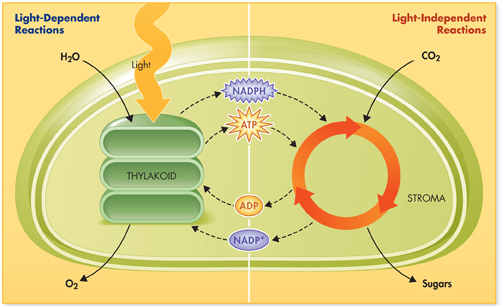Light-Dependent Reactions Although the equation for photosynthesis looks simple, there are many steps to get from the reactants to the final products. In fact, photosynthesis actually involves two sets of reactions. The first set of reactions is known as the light-dependent reactions because they require the direct involvement of light and light-absorbing pigments. The light-dependent reactions use energy from sunlight to produce energy-rich compounds such as ATP. These reactions take place within the thylakoids—specifically, in the thylakoid membranes—of the chloroplast. Water is required in these reactions as a source of electrons and hydrogen ions. Oxygen is released as a byproduct.
Light-Independent Reactions Plants absorb carbon dioxide from the atmosphere and complete the process of photosynthesis by producing carbon-containing sugars and other carbohydrates. During the light-independent reactions, ATP and NADPH molecules produced in the light-dependent reactions are used to produce high-energy sugars from carbon dioxide. As the name implies, no light is required to power the light-independent reactions. The light-independent reactions take place outside the thylakoids, in the stroma.
The interdependent relationship between the light-dependent and light-independent reactions is shown in Figure 8–7. As you can see, the two sets of reactions work together to capture the energy of sunlight and transform it into energy-rich compounds such as carbohydrates.
 In Your Notebook Create a two-column compare/contrast table that shows the similarities and differences between the light-dependent and light-independent reactions of photosynthesis.
In Your Notebook Create a two-column compare/contrast table that shows the similarities and differences between the light-dependent and light-independent reactions of photosynthesis.
BUILD Vocabulary
ACADEMIC WORDS The noun byproduct means “anything produced in the course of making another thing.” Oxygen is considered a byproduct of the light-dependent reactions of photosynthesis because it is produced as a result of extracting electrons from water. Also, unlike ATP and NADPH, oxygen is not used in the second stage of the process, the light-independent reactions.

FIGURE 8–7 The Stages of Photosynthesis There are two stages of photosynthesis: light-dependent reactions and light-independent reactions. Interpret Diagrams What happens to the ATP and NADPH produced in the light-dependent reactions?
d
Table of Contents
- Formulas and Equations
- Applying Formulas and Equations
- Mean, Median, and Mode
- Estimation
- Using Measurements in Calculations
- Effects of Measurement Errors
- Accuracy
- Precision
- Comparing Accuracy and Precision
- Significant Figures
- Calculating With Significant Figures
- Scientific Notation
- Calculating With Scientific Notation
- Dimensional Analysis
- Applying Dimensional Analysis




